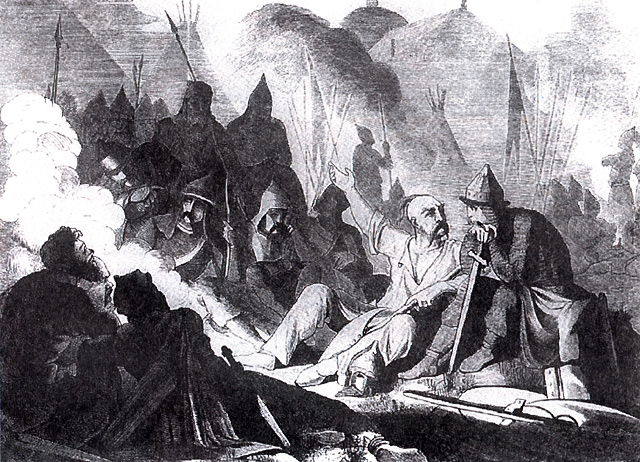Battle of Dorostolon on:
[Wikipedia]
[Google]
[Amazon]
 The Battle of Dorostopol was fought in 971 between the
The Battle of Dorostopol was fought in 971 between the
 The siege is described in detail by John Skylitzes and Leo the Deacon, although some of their assertions (e.g., Sveneld's death during the siege) appear to be apocryphal. Characteristically, Leo the Deacon attributes the victory to Saint Theodore Stratelates, who purportedly led the Byzantine army under the walls of Dorostolon.
The siege is described in detail by John Skylitzes and Leo the Deacon, although some of their assertions (e.g., Sveneld's death during the siege) appear to be apocryphal. Characteristically, Leo the Deacon attributes the victory to Saint Theodore Stratelates, who purportedly led the Byzantine army under the walls of Dorostolon.
 The Battle of Dorostopol was fought in 971 between the
The Battle of Dorostopol was fought in 971 between the Byzantine Empire
The Byzantine Empire, also referred to as the Eastern Roman Empire or Byzantium, was the continuation of the Roman Empire primarily in its eastern provinces during Late Antiquity and the Middle Ages, when its capital city was Constantinopl ...
and forces of Kievan Rus'. The Byzantines, led by John I Tzimiskes, were victorious.
Background
During the course of the Rus'-Bulgarian war, Svyatoslav I of Kiev overran the eastern part of the First Bulgarian Empire and established his capital at Pereyaslavets on the Danube. Once John I usurped the throne, the Byzantines launched a counteroffensive. After they defeated the united Rus'-Bulgarian forces in the Battle of Arcadiopolis (970), Battle of Arcadiopolis and recaptured Pereyaslavets, Svyatoslav was forced to flee to the northern fortress of Silistra, Dorostolon (Drustur/Dorostorum).Siege
Emperor John proceeded to lay siege to Dorostolon, which lasted for 65 days. His army was reinforced by a fleet of 300 ships equipped with Greek fire.Treadgold, Warren. ''A History of the Byzantine State and Society''. Stanford University Press, 1997, , p. 509. There were several engagements before the walls of the city, which demonstrated to the Byzantines that the Rus' lacked skill in cavalry warfare. Among the casualties were the Emperor's relative, John Kourkouas (died 971), John Kourkouas (whose severed head was displayed by the Rus' from one of the towers) and the second-in-command in Svyatoslav's army, a certain Ikmor (who was killed by Anemas (died 971), Anemas, a son of the last Emirate of Crete, Cretan emir, in revenge for Ikmor's assassination of his father during the Byzantine siege of Crete). The Rus' and their Bulgarian allies were reduced to extremities by famine. In order to appease their gods, they drowned children in the Danube, but the sacrifices failed to improve their position. During the siege of the city of Dorostolon the Rus forces were reduced to near starvation, and a force of some 2,000 warriors, including women, made a surprise sally out during the night to search for supplies and managed to defeat a Byzantine force on the way, returning later to the city. The Rus' felt they could not break the siege and agreed to sign a peace treaty with theByzantine Empire
The Byzantine Empire, also referred to as the Eastern Roman Empire or Byzantium, was the continuation of the Roman Empire primarily in its eastern provinces during Late Antiquity and the Middle Ages, when its capital city was Constantinopl ...
, whereby they renounced their interests towards the Bulgarian lands and the city of Chersonesos Taurica, Chersonesos in Crimea. Svyatoslav bitterly remarked that all his allies (Magyars, Pechenegs) betrayed him during this decisive moment. He was allowed to evacuate his army to Berezan Island, while the Byzantines entered Dorostolon and renamed it Theodoropolis, after the reigning empress Theodora, daughter of Constantine VII, Theodora.
After the eventual defeat of the Rus, the Byzantines were astonished at finding the bodies of armed women among the fallen warriors.Harrison, D. & Svensson, K. (2007). ''Vikingaliv''. Fälth & Hässler, Värnamo. . p. 71
Sources
 The siege is described in detail by John Skylitzes and Leo the Deacon, although some of their assertions (e.g., Sveneld's death during the siege) appear to be apocryphal. Characteristically, Leo the Deacon attributes the victory to Saint Theodore Stratelates, who purportedly led the Byzantine army under the walls of Dorostolon.
The siege is described in detail by John Skylitzes and Leo the Deacon, although some of their assertions (e.g., Sveneld's death during the siege) appear to be apocryphal. Characteristically, Leo the Deacon attributes the victory to Saint Theodore Stratelates, who purportedly led the Byzantine army under the walls of Dorostolon.
References
Sources
*Andrey Nikolayevich Sakharov. ''Svyatoslav's Diplomacy''. Moscow: Mezhdunarodnye otnosheniya, 1982. *Fyodor Uspensky. ''The History of the Byzantine Empire'', vol. 2. Moscow: Mysl, 1997. * * * {{DEFAULTSORT:Dorostolon Sieges involving the Byzantine Empire Battles involving Kievan Rus' Sieges involving the First Bulgarian Empire Sieges of the Middle Ages History of Silistra 970s in the Byzantine Empire 10th century in Bulgaria 970s conflicts 971 10th century in Kievan Rus'